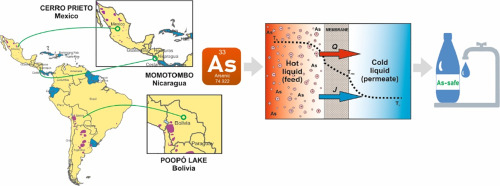当前位置:
X-MOL 学术
›
Sci. Total Environ.
›
论文详情
Our official English website, www.x-mol.net, welcomes your
feedback! (Note: you will need to create a separate account there.)
Use of low-enthalpy and waste geothermal energy sources to solve arsenic problems in freshwater production in selected regions of Latin America using a process membrane distillation - Research into model solutions.
Science of the Total Environment ( IF 8.2 ) Pub Date : 2020-01-22 , DOI: 10.1016/j.scitotenv.2020.136853 Barbara Tomaszewska 1 , Jochen Bundschuh 2 , Leszek Pająk 1 , Marta Dendys 1 , Valeria Delgado Quezada 3 , Michał Bodzek 4 , Maria Aurora Armienta 5 , Mauricio Ormachea Muñoz 6 , Aleksandra Kasztelewicz 7
Science of the Total Environment ( IF 8.2 ) Pub Date : 2020-01-22 , DOI: 10.1016/j.scitotenv.2020.136853 Barbara Tomaszewska 1 , Jochen Bundschuh 2 , Leszek Pająk 1 , Marta Dendys 1 , Valeria Delgado Quezada 3 , Michał Bodzek 4 , Maria Aurora Armienta 5 , Mauricio Ormachea Muñoz 6 , Aleksandra Kasztelewicz 7
Affiliation

|
The challenge for many communities in Latin America is to find adequate solutions which are feasible given the local economic and technical conditions and which enable them to source water with arsenic concentrations below the WHO guideline value for drinking water (<10 μg/L) of arsenic (As) pollution, suitable for human consumption and the irrigation of crops. Three regions where geothermal fields are present were selected for study out of the several hundred locations in Latin America where the water environment is contaminated with As and where there is a critical water shortage problem. These are Cerro Prieto in Mexico, Momotombo in Nicaragua and Lake Poopó in Bolivia. The paper presents the results of research on the use of low-enthalpy geothermal energy sources and waste heat from geothermal power plants in membrane distillation (MD) processes, which is the only heat-powered membrane technology, in order to obtain potable water and/or water for crop irrigation. It was concluded that MD could be considered as a solution for obtaining water of good quality with a high retention of toxic solutes such as As as well as other different species found in groundwater. In addition, it is not only geothermal energy, but also the geothermal water itself that can be considered as a source of freshwater produced through the MD process, a process which is most suitable to be used in areas where cheap sources of heat are available.
中文翻译:

使用低焓和废地热能源,通过工艺膜蒸馏解决拉丁美洲特定地区淡水生产中的砷问题-研究模型解决方案。
拉丁美洲许多社区面临的挑战是要找到适当的解决方案,这些解决方案应根据当地的经济和技术条件而可行,并使他们能够获取砷浓度低于世界卫生组织饮用水砷标准值(<10μg/ L)的砷。 (As)污染,适合人类食用和农作物灌溉。在拉丁美洲数百个水环境中被砷污染且存在严重缺水问题的地区中,选择了三个存在地热场的区域进行研究。这些是墨西哥的Cerro Prieto,尼加拉瓜的Momotombo和玻利维亚的Poopó湖。本文介绍了在膜蒸馏(MD)工艺中使用低焓地热能源和地热发电厂废热的研究结果,膜蒸馏是唯一的热动力膜技术,目的是获得饮用水和/或用于农作物灌溉的水。结论是,MD可以被认为是一种获得高质量水的解决方案,该水具有很高的毒性溶质,如As以及地下水中发现的其他不同种类的溶质。此外,不仅是地热能,而且地热水本身也可以被视为通过MD工艺生产的淡水源,该工艺最适合用于廉价热源可用的地区。为了获得饮用水和/或用于农作物灌溉的水。结论是,MD可以被认为是一种获得高质量水的解决方案,该水具有很高的毒性溶质,如As以及地下水中发现的其他不同种类的溶质。此外,不仅是地热能,而且地热水本身也可以被视为通过MD工艺生产的淡水源,该工艺最适合用于廉价热源可用的地区。为了获得饮用水和/或用于农作物灌溉的水。结论是,MD可以被认为是一种获得高质量水的解决方案,该水具有很高的毒性溶质,如As以及地下水中发现的其他不同种类的溶质。此外,不仅是地热能,而且地热水本身也可以被视为通过MD工艺生产的淡水源,该工艺最适合用于廉价热源可用的地区。
更新日期:2020-01-22
中文翻译:

使用低焓和废地热能源,通过工艺膜蒸馏解决拉丁美洲特定地区淡水生产中的砷问题-研究模型解决方案。
拉丁美洲许多社区面临的挑战是要找到适当的解决方案,这些解决方案应根据当地的经济和技术条件而可行,并使他们能够获取砷浓度低于世界卫生组织饮用水砷标准值(<10μg/ L)的砷。 (As)污染,适合人类食用和农作物灌溉。在拉丁美洲数百个水环境中被砷污染且存在严重缺水问题的地区中,选择了三个存在地热场的区域进行研究。这些是墨西哥的Cerro Prieto,尼加拉瓜的Momotombo和玻利维亚的Poopó湖。本文介绍了在膜蒸馏(MD)工艺中使用低焓地热能源和地热发电厂废热的研究结果,膜蒸馏是唯一的热动力膜技术,目的是获得饮用水和/或用于农作物灌溉的水。结论是,MD可以被认为是一种获得高质量水的解决方案,该水具有很高的毒性溶质,如As以及地下水中发现的其他不同种类的溶质。此外,不仅是地热能,而且地热水本身也可以被视为通过MD工艺生产的淡水源,该工艺最适合用于廉价热源可用的地区。为了获得饮用水和/或用于农作物灌溉的水。结论是,MD可以被认为是一种获得高质量水的解决方案,该水具有很高的毒性溶质,如As以及地下水中发现的其他不同种类的溶质。此外,不仅是地热能,而且地热水本身也可以被视为通过MD工艺生产的淡水源,该工艺最适合用于廉价热源可用的地区。为了获得饮用水和/或用于农作物灌溉的水。结论是,MD可以被认为是一种获得高质量水的解决方案,该水具有很高的毒性溶质,如As以及地下水中发现的其他不同种类的溶质。此外,不仅是地热能,而且地热水本身也可以被视为通过MD工艺生产的淡水源,该工艺最适合用于廉价热源可用的地区。











































 京公网安备 11010802027423号
京公网安备 11010802027423号